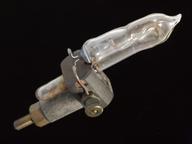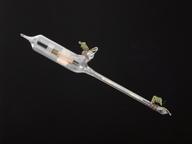

Aerial assembly from Sea Watch Major radar beacon, made by GEC-AEI (Electronics) in Leicester, 1968. The "Sea Watch Major" produced a distinctive response on the screen of any 3-cm marine radar operating within its range of maximum 55 kilometres.
Separate receiving and transmitting aerials were employed, vertically offset to minimise mutual interaction but otherwise identical. Each consisted of a length of waveguide, slotted back and front, and terminated just above the slots by a movable plunger. Wedge-shaped ‘wings’ gave the aerials an omnidirectional response in the horizontal plane. A plastic ‘radome’ protected the aerials from the weather and was made half a wavelength thick so that cancellation occurred between the reflections generated, in antiphase, at its inner and outer surfaces.
The aerials followed a design originated by the Admiralty Signal and Radar Establishment in 1951.
Marine radar beacons (also known as ‘racons’) such as the Sea Watch Major and later the Sea Watch 3000 were developed by GEC-AEI (Electronics) in Leicester in 1968 and 1969 to increase safety in dangerous coastal areas and were initially experimented with in 1969 and 1970.
Marine radar beacons were ‘triggered’ by a ship’s radar signal and transmitted back position information. The signals they transmitted could be coded to enable the vessel’s radar display to show the range, bearing and identity of the site. Such information simplified ship navigation near land or in difficult waters.
The “Sea Watch Major” radar aerial beacon, of which this is the aerial assembly, was installed on a number of lighthouses and lightships, principally around the coasts of Scotland and Ireland.
Details
- Category:
- Radio Communication
- Object Number:
- 1971-151
- type:
- radar beacon equipment
- credit:
- GEC-AEI (Electronics) Limited




